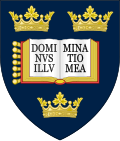


The Oxford Science Park (OSP) is a science and technology park [1] located on the southern edge of the city of Oxford, England. It was officially opened in 1991 and is owned by Magdalen College, Oxford. The park maintains strong links with the nearby University of Oxford and currently[ when? ] contains just over 60 companies.
